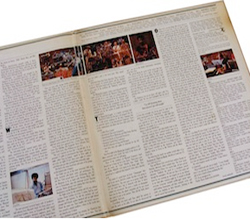I think it’s safe to say that we’re at the end of the “album age,” and although the format will hold on for a while, it’s clearly waning in popularity.
I’ve given this a lot of thought and have come up with what I think are the reasons, but be aware, they’re not all exactly what the popular wisdom assumes.
So let’s begin with the six reasons why the album format has, for all intents and purposes, died.
1) It was a visual experience. The album format in the vinyl record age had the advantage of that wonderful piece of cardboard known as the album jacket.
The album jacket contained the cover art (still found on CDs), and most importantly, the liner notes on the back, which we’ll get to in a second. But one thing that everyone either forgets or has never experienced is the fact that millions of albums were purchased completely on impulse because of the album artwork alone!
It may be hard to believe, but it was quite common to come across an album cover that was so cool that you’d buy it without knowing a thing about the artist. Sometimes it would be a total loser, but you still had the liner notes to read, and occasionally that would still make it a worthwhile purchase.
2) It was an informational experience too. Those of you too young to have experienced this don’t know how much the liner notes meant to nearly everyone who bought an album (the picture on the left gives you an idea how extensive they could be).
You could spend hours reading a well-written gatefold jacket, checking out every credit, wondering just where these exotic studios were (Smoketree Ranch in Malibu was the one that always intrigued me the most as a kid), and generally just soaking up any info you could about the artist.
Of course, this was way, way before the Internet, so the liner notes were sometimes the only place to find any of info on the artist at all.
To say the least, the visuals and information along with the music made buying an album a total experience that today’s album doesn’t some close to.
3) The demise of the record stores. Once again, this may seem hard to believe but nearly every community had someplace that sold records, even if it didn’t have a record store.
There was an entire network set up to supply records to department stores, supermarkets, even diners. You couldn’t help but to run into someplace selling records during the course of a day.
But the record store was the place to not only buy music, but to spend hours browsing. Why? Because of the cover art and liner notes. You’d peel through a bin of records, stopping every so often to look at an intriguing cover, which made you want to read the liner notes, and maybe even buy the album as a result.
But the record store was also the best place for word of mouth. The people that worked the record stores always knew what was hot, what was underground but about to pop, and what was overhyped. You could go into a store and ask a clerk, “What’s really good?” and he’d give you 10 choices, most of which were pretty high quality.
This is something that the music industry is still looking for today online. Now we call it “music discovery” and VC’s still throw big money at anyone who claims to have an app.
















